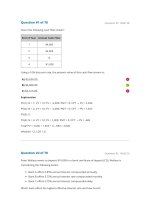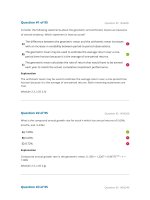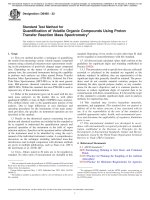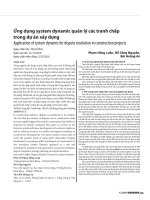interactive identification key for female mosquitoes diptera culicidae of euro mediterranean and black sea regions
Bạn đang xem bản rút gọn của tài liệu. Xem và tải ngay bản đầy đủ của tài liệu tại đây (65.79 KB, 2 trang )
110
Abstracts / International Journal of Infectious Diseases 53S (2016) 4–163
20.035
Fast-track Diagnostics Enteric fever assay: From
pre-enrichment to multiplex real-time PCR
E. Nicolas a,∗ , S. Pouzol b , L. Fabre c , F.-X. Weill c , H.
Endtz d , B. Carman e
a
Fast-track Diagnostics, Esch-sur-Alzette/LU
Fondation Mérieux, Lyon/FR
c Institut Pasteur, Paris/FR
d ICDDR,B, Dhaka/BD
e Fast-track Diagnostics, Luxembourg/LU
b
Purpose: Enteric fever due to Salmonella remains a significant
public health problem, predominantly in children in developing
countries. Typhoid fever affects more than 20 million people per
year associated to about 300,000 deaths. These high rates are
mainly due to the lack of fast, reliable and inexpensive diagnostic assays. Diagnosis of typhoid remains a challenge because a low
bacterial load can be responsible of an illness and also because the
volume of blood that can be collected from children is limited.
To overcome the problem of sensitivity, the first goal of this
study was to define an appropriate pre-enrichment method of
the collected sample before nucleic-acid extraction. The second
objective was to develop a sensitive multiplex real-time PCR assay
for detection of the common etiological agents of Enteric fever:
Salmonella enterica spp., Salmonella typhi and Salmonella paratyphi A.
Methods & Materials: To determine the best pre-enrichment
medium, we spiked S. paratyphi A within blood samples, added
the enrichment medium, cultured for 5 h at 37 ◦ C, performed
nucleic acid extraction and determined the yield of specific nucleic
acids by real-time PCR. We tested several commercial enrichment
broths and a home-made TSB medium supplemented with Oxgall
(inhibitor of Gram+ bacteria). The results show that the Selenite
broth (Copan) and the TSB-Oxgall medium are the most efficient
pre-enrichment methods of free bacteria in blood samples.
Results: In parallel we developed a multiplex real-time PCR
assay that distinguish between infection by S. enterica spp., S. typhi
and/or S. paratyphi A (+ internal control). This assay shows a limit
of detection between 1E+02 and 1E+03 copies/ml and a linearity
from 1E+09 to 1E+03 copies/ml for all pathogens. The specificity of
the assay was validated with various negative samples which did
not generate any positive signals. Furthermore, different positive
materials containing bacteria, parasites, and viruses were evaluated with this assay and no other than the expected bacteria were
detected.
Conclusion: In conclusion, this study shows the development
of an efficient diagnostic pipeline that combines a quick preenrichment of infected blood samples with a sensitive real-time
multiplex PCR assay that could be used as a reference diagnostic
method for Enteric fever infectious agents.
/>20.037
Effectiveness of measuring blood antibody titer
and biofilm-forming ability in Staphylococcus
aureus bacteremia
M. Yamashita
Department of Medical Engineering Faculty of Health
Care Science Himeji Dokkyo University, Himeji/JP
Purpose: To examine the effectiveness of measuring
anti-Staphylococcus aureus antibody titers in the blood and
biofilm-forming ability of the pathogen as supporting evidence for
the diagnosis of bacteremia in patients with S. aureus infection.
Methods & Materials: Anti-S. aureus antibody titers in the blood
were measured by ELISA using protein A-deficient S. aureus. The
biofilm-forming ability was measured using the tissue culture plate
method.
Results: Regarding anti-S. aureus antibody titers, the patient
group showed significantly higher IgG and IgA antibody titers compared with the healthy control group. There was no significant
difference in IgM antibody titers between the patient and healthy
control groups. Furthermore, significantly higher IgG and IgA antibody titers were observed in the bloodstream infection group
compared with the respiratory tract infection group. In the bloodstream infection group, the IgA antibody titers of the 27 patients
for whom multiple measurements could be obtained over time
were elevated prior to positive blood culture and subsequently
decreased; of these patients, six with a poor prognosis died. In
patients for whom the blood culture was negative, IgA antibody
titers tended to be elevated or unchanged. There was no marked
change in IgG antibody titers.
With regard to the biofilm-forming ability, there was no
significant difference between MSSA and MRSA. However, the
examination of a possible relationship with prognosis in bacteremia cases by surveying the inpatient medical records of items,
including leukocyte count, CRP, the presence or absence of fever,
and outcomes, revealed that patients with a poor prognosis exhibited a significantly higher biofilm-forming ability than those with
a good prognosis. It is believed that an OD value of 0.8 or above
indicates strong adhesiveness. Furthermore, no relationship was
observed between IgG antibody titer, IgA antibody titer, and
biofilm-forming ability.
Conclusion: Patients with bacteremia show significantly higher
anti-S. aureus antibody titers, and it is believed that the production
of large volumes of IgA antibodies can improve their condition. Conversely, low titers suggest a poor prognosis. Results also suggested
that biofilm-forming ability is associated with prognosis in patients
with bacteremia.
/>20.041
Interactive Identification Key for Female
Mosquitoes (Diptera: Culicidae) of
Euro-Mediterranean and Black Sea Regions
F. Gunay a , M. Picard b,∗ , V. Robert b
a
Hacettepe University, Faculty of Sciences,
Department of Biology, Division of Ecology,
Ankara/TR
b IRD, MIVEGEC, Montpellier/FR
Purpose: In the context of the recent introduction of invasive
species, an urgent need for a user-friendly identification key for
mosquitoes has resurfaced among entomologists and health care
officials. As the MediLabSecure medical entomology network team,
our experience has shown that it is essential to have a tool that
can be used freely, online and offline, by both specialists and nonspecialists.
Methods & Materials: 134 mosquito species are included in this
tool. These mosquitoes are distributed in 65 countries in Europe,
North Africa, the Black Sea area and Middle East. Morphological
descriptors for female identification are used to build a comprehensive database. This morphological database was consequently
edited using the computer software Xper2 , a useful tool to create
interactive and easy to use identification keys.
Abstracts / International Journal of Infectious Diseases 53S (2016) 4–163
Results: This interactive morphological identification key was
developed using 57 morphological characters (descriptors): 11 on
the head, 15 on the thorax, 9 on wings, 22 on legs and 6 on the
abdomen. Geographic distribution is another very useful character where more than one country could be selected. All descriptors
have detailed description, along with a picture or an illustration.
Priority was to line up the descriptors, considering non-experts
will use the tool so characters that are more visible than others
come first. As an option there are three different models that can
choose the question with the higher discriminant power that leads
to a quicker identification. It allows the user to see the descriptors,
states, definitions, images and all taxa on the same page.
Conclusion: Training sessions organized in the frame of the
MediLabSecure Project, with participants from many of the selected
countries in this task, have brought to light that a tool to train inexperienced users is a must. This identification key will be available in
January 2017. This multi-entry key will allow using descriptors the
user can observe. This will help when some body parts are missing
on the sample since it’s possible to select a group of descriptors.
Future plans are to include a key for fourth instar larva and to
perform validation tests on entomologists with variable degrees
of experience.
/>20.043
Implementation of GastroBusters in Toronto:
Canada’s First Online Reporting System for
Foodborne Illness
A.A.A. Arthur ∗ , S. Ota, E. Gournis
Toronto Public Health, Communicable Disease
Control, Toronto/CA
Purpose: Foodborne illness (FBI) is greatly under-reported
to public health. Toronto Public Health implemented an online
reporting option, GastroBusters, for the public in July 2015, in
preparation for the Pan and Parapan American Games (PPAG). Mass
events increase risk of FBI and also involve visitors who may not
access local health services unless acutely ill. System objectives
included: (1) improved ability to detect FBI clusters/outbreaks, (2)
more timely data for public health interventions, (3) better estimates of FBI in Toronto, and 4) potential use as a legacy system for
routine surveillance.
Methods & Materials: FluidSurveys was used to create a user
friendly, secure, online data collection tool. Users had the option
to provide their contact information, with clear indication that this
would permit contact by a public health investigator. A 3-day food
history was requested, with prompts for large events (e.g., PPAG)
that were attended. Nominal reports were escalated for followup within two hours of receipt; exposure data from both nominal
and non-nominal reports were analysed with other surveillance
data sources to identify commons exposures. Data were collated in
MS Access and analyzed using SASv9.3. GastroBusters was piloted
during the PPAG and then evaluated after 6 months.
Results: Between August 1, 2015 and January 31, 2016, 211
food poisoning reports were submitted through GastroBusters;
79% were not reported by another surveillance data source (e.g.,
telephone or food premise complaint). Two-thirds (67%) provided
contact information permitting public health follow-up. Eightyfive reports prompted a food premise inspection, to identify and
mitigate food safety infractions. Of these, 15 (18%) identified critical infractions and three premises were closed. No widespread
community outbreaks or clusters of illness were detected by any
111
surveillance sources during the pilot period, including during the
PPAG.
Conclusion: Providing an online reporting option yielded valuable and timely information on FBI in Toronto. Integration with
a food safety and premise inspection program can trigger actions
needed to protect the public from further illness. GastroBusters is
the first online FBI reporting tool implemented in Canada, and is a
valuable legacy of the PPAG that can be used to complement other
surveillance data sources.
/>20.044
Harvesting Real Time and Historical Disease
Outbreak Data from the ProMED-Mail Database:
Pitfalls and Proposed Solutions
C.E.B. Carslake
University of Bristol, Veterinary Science, Bristol/UK
Purpose: Internet based disease reporting systems are potential
sources of vast amounts of data that can be incorporated into epidemiological models investigating disease distribution and drivers.
However steps must firstly be taken in order to address the veracity, volume and variety of the available data. This poster details our
attempt to harvest and transform online disease outbreak reports
from Pro-MED mail into reliable and usable data detailing infectious
disease outbreaks in humans and animals at a country level.
Methods & Materials: ProMED-mail issues reports regarding
disease outbreaks as well as requests for information, collegial
notifications (conferences, publications) and other information.
Unfortunately for the epidemiologist the type of information contained within the report, as viewable through Health Map, is not
immediately ascertainable. In addition the information contained
within the species field is often unreliable and the location reported
is occasionally that of the information source not the outbreak.
We propose an automated method to harvest infectious disease outbreak information from the ProMED-mail reports. Firstly
individual reports are grouped into disease events (a series of individual reports of the same disease occurring within a specified time
frame and location) thereby eliminating individual reports that do
not relate to disease outbreaks. Secondly an algorithm infers the
species affected by scanning the grouped reports for key words
and checking the compatibility of the species identified with the
disease reported.
Results: Grouping reports of the same disease at the country
level with a maximum of 21 days between each report transforms
the 65492 reports over 10 years into 9436 disease events containing
51023 reports. Each disease event can be reliably attributed to an
outbreak.
The grouping of the reports into disease events allows a more
accurate representation of the species affected. The original data
did not identify a species in 14% of reports. Our algorithm identified
a species in all but 1% of disease events.
Conclusion: Our methodology allows the creation of a database
documenting the distribution of animal and human disease outbreaks worldwide. We aim to integrate this ‘One Health’ database
with a wealth of other data resources in order to characterise and
quantify disease drivers through data modelling techniques.
/>





